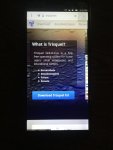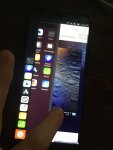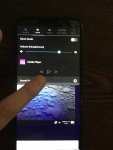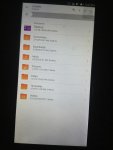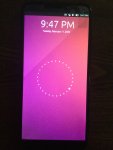pinephone arrived
- Vous devez vous identifier ou créer un compte pour écrire des commentaires
My Pinephone arrived yesterday evening. Here's my experience so far.
### Installing PostmarketOS
While waiting for the PinePhone to arrive, I followed [these instructions][1] to build a PostmarketOS image and install it to a microSD card.
While building the image, the user is prompted to select a desktop environment. The two options that seemed worth testing were Phosh (which seems to be GNOME with modifications by Purism to be more mobile-friendly) and Plasma Mobile.
The user is also prompted to decide whether or not to include the non-free firmware needed for the WiFi/Bluetooth card. I selected "yes". While I would prefer free firmware for the WiFi card, I consider the modem to be much more problematic than non-free WiFi firmware, and without the WiFi card the modem would be the only sane way to connect to the Internet. Yes, it would be possible to buy a USB-C to USB adapter and use an Atheros WiFi dongle, but I don't honestly expect any normal person to do that, and I am seeking a setup I can recommend to others (I don't need a cell phone for myself).
[1]: https://wiki.postmarketos.org/wiki/Installation_guide
### Killswitches
When I read about the killswitches, I assumed that they would be on the edge of the device. When the Pinephone arrived, I found that they are actually underneath the back cover of the device, and very small. In order to use the killswitches, one needs to remove the back cover of the device and use a finely pointed object (I used a staple) to flip them. I suppose that this makes sense, as most users probably will probably not use the switches very frequently and would rather not risk disabling a hardware component accidentally, but I wish that the modem switch were more easily accessible.
There are kill switches for the following.
* modem
* WiFi/Bluetooth
* microphone
* rear camera
* front camera
* headphone
Since I don't have a SIM card to test with at this time, the modem would not allow me to do anything except call emergency services (and I don't think outgoing calls work yet anyway), so I've disabled the modem for better privacy while leaving the other hardware devices enabled.
### Booting into the Test Image
The only OS preinstalled to the eMMC is a PostmarketOS-based image for testing hardware components. It takes about 10 seconds to boot. The modem test did not succeed, but this is of course the expected behavior when the modem is disabled with the killswitch. All the other hardware copmonents work.
### Booting into PostmarketOS
This turned out to be quite painless. I inserted the microSD card, powered the phone on, and it defaulted to booting to PostmarketOS. Booting takes a long time (about two minutes). I hope that this is beacuse I am booting from a microSD card, and that after installing an OS to the eMMC it will have a similar boot time to the preinstalled test image. I plan to distro- and desktop-hop for a while, so I am not bothering to install anything to the eMMC yet.
### Desktop Environments
Neither Plasma Mobile nor Phosh are really usable yet, but both seem promising. Phosh is a little more responsive and the window manager doesn't do weird things as often. I like the design of Phosh better, but I also prefer GNOME over Plasma Desktop, so this is just personal preference. Plasma Mobile is more "complete", in that more important desktop utilities have been made mobile friendly. GNOME tweak, for example, is unusable in Phosh. I actually got further configuring Phosh than Plasma Mobile, but that's because I'm familiar enough with GNOME to be comfortable configuring it from the command line.
### Doing Anything Useful
I could not get the camera to work in either desktop environment.
Connecting to the Internet was a pain with both desktop environments. With Plasma the GUI network manager worked, but took a very long time to connect. With Phosh the GUI did not work at all and I had to connect via the command line using `nmtui`.
Once connected to the Internet, I tried to browse the web. With both Angelfish (Plasma Mobile's default browser) and Epiphany (Phosh's default browser), I was unable to load the content of any web pages. I know that a connection is being made to the sites, because the page title can be loaded. For example, if I enter "https://trisquel.info" into the URL, the name of the tab in Epiphany changes to "Trisquel GNU/Linux - Run Free!", but the page never loads. I also installed Firefox when testing Phosh, and Firefox not only could not load pages either, but also did not play nicely with Phosh's window manager.
The next thing I tried was setting up a Jabber client, which would allow me to send SMS messages using my JMP number. Plasma's default chat client did not provide an obvious way to add an account (or to do anything), but Phosh's default did work (after figuring out that I needed to install the `libpurple-xmpp`, and `cyrus-libsasl` packages). I was able to send/receive messages to/from my friend's phone. Having managed to accomplish one useful thing after 10 hours of working with the device, I decided to call it a day and make this post.
### Conclusion
PostmarketOS looks promising, as do both Plasma Mobile and Phosh, though they have a ways to go before they are ready for serious use. I'll keep testing and see how they progress. I may also try Ubuntu Touch. Once one of these distros and desktops is far enough along for a normal person to tolerate, and once normal SMS and phone calls are possible, I'll start lending it to friends with SIM cards who are willing to try it out, and hopefully get them interested in ditching iOS/Android whenever the final Pinephone units are available.
I took some photos. They might show up [here][2] eventually? This is the first time I've tried MediaGoblin. The photos are listed but don't appear to be actually available, so maybe they're still uploading?
[2]: https://goblinrefuge.com/mediagoblin/u/chaosmonk/collection/pinephone/
Thank you for sharing this info.
Could you also paste the output of:
grep . /sys/devices/system/cpu/vulnerabilities/*
lscpu
uname -a
> grep . /sys/devices/system/cpu/vulnerabilities/*
grep: /sys/devices/system/cpu/vulnerabilities/*: No such file or directory
> lscpu
I don't have an easy way to copy/paste this output from the phone to a web browser, so I'm just going to type out the part of the output I think you are interested in:
Vulnerability Itlb multihit: Not affected
Vulnerability L1tf: Not affected
Vulnerability Mds: Not affected
Vulnerability Meltdown: Not affected
Vulnerability Spec store bypass: Not affected
Vulnerability Spectre v1: Mitigation; __user pointer sanitization
Vulnerability Spectre v2: Not affected
Vulnerability Tsx async abort: Not affected
> uname -a
Linux pine64-pinephone 5.4.0 #2-postmarketos-allwinner SMP Sat Dec 7 14:14:33 UTC 2019 aarch64 Linux
> grep: /sys/devices/system/cpu/vulnerabilities/*: No such file or directory
Sorry, I must have made a typo the first time I ran this. Here is the output:
/sys/devices/system/cpu/vulnerabilities/itlb_multihit
/sys/devices/system/cpu/vulnerabilities/l1tf
/sys/devices/system/cpu/vulnerabilities/mds
/sys/devices/system/cpu/vulnerabilities/meltdown
/sys/devices/system/cpu/vulnerabilities/spec_store_bypass
/sys/devices/system/cpu/vulnerabilities/spectre_v1
/sys/devices/system/cpu/vulnerabilities/spectre_v2
/sys/devices/system/cpu/vulnerabilities/tsx_async_abort
Thanks!
It is weird that grep doesn't output the actual content of these files. Is it possible that your 'grep' is an alias to the real grep with options (e.g. to 'grep -l')?
You could also try:
tail -n +1 /sys/devices/system/cpu/vulnerabilities/*
Other than that: what lscpu shows looks very very good!
> Once one of these distros and desktops is far enough along for a normal person to tolerate, and once normal SMS and phone calls are possible
I am not sure if I understand what you mean. Are you saying that currently this phone cannot be used as a phone? Is it because you turned the modem switch off or is it something else?
I am trying to understand if this phone is usable at all as from your shared experience it sounds like a promising but useless prototype. I hope you can clarify.
> https://trisquel.info/files/plasma-apps.png.jpg
Why does this show Okular 3 times and Trojita 2 times?
> It is weird that grep doesn't output the actual content of these files. Is it possible that your 'grep' is an alias to the real grep with options (e.g. to 'grep -l')?
PostmarketOS uses musl instead of GNU, so it could be that musl grep behaves differently from GNU grep. I have never used musl until now, but I've used busybox and have noticed that busybox grep lacks many options and features of GNU grep.
> tail -n +1 /sys/devices/system/cpu/vulnerabilities/*
This did print the contents. The information is the same as the output of `lscpu`: they all say "Not affected" except for spectre_v1 which says "Mitigation; __user pointer sanitization".
> Are you saying that currently this phone cannot be used as a phone? Is it because you turned the modem switch off or is it something else?
I have heard that UBports has got incoming calls working (not outgoing), but I think don't think any of the distros targeting the PinePhone have it working as a fully functional phone yet.
> I am trying to understand if this phone is usable at all as from your shared experience it sounds like a promising but useless prototype.
Yes, it is mostly useless right now, but I knew that going in. The PinePhone is only ready hardware-wise, not software-wise. The purpose of the PinePhone Braveheart edition is to get the device in the hands of advanced users who are willing to help test the different distros targeting the PinePhone. The Pinephone will be officially released once there are stable and fully functional distros to ship it with.
> Why does this show Okular 3 times and Trojita 2 times?
I'm not sure. I'll have to reinstall Plasma Mobile to check. My guess is that those applications have multiple .desktop files, only one of which is meant to show up in menus.
I see.
Thanks for the info!
Then what about Unity? There's already quite a few Ubuntu phones, so it's usability should be better.
BTW, the legacy Unity 7.x has one last year of life (Ubuntu 16.04 LTS). I hope Unity 8.x can be adopted by Debian this year, so I can forget all other desktop environments.
Why do you prefer Unity over GNOME?
Unity was by far my favorite desktop environment. I'm also very curious why there are so many users so negative toward Unity.
> Then what about Unity? There's already quite a few Ubuntu phones, so it's usability should be better.
Unity depends on Ubuntu-specific patches to Gtk3, so it is hard to port to other distros and likely won't be packaged anytime soon for PostmarketOS (which seems to be the most freedom-minded of the major mobile distros) or Debian (the other distro I am interested in trying on the Pinephone). However, I may try UBports at some point and see if Ubuntu Touch is any good.
In contrary, Unity 8.x is being packaged by developer(s) from UBports for Debian. I'm looking forward to its adoption by Debian.
Even UKUI had been adopted by Debian, then why can't (or shouldn't) Unity?
MediaGoblin does not seem to be working out, so I'm posting the photos here.






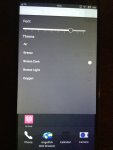






I just installed Ubuntu Touch. I'm not an Ubuntu fan and I've never really liked Unity, but I have to give UBports a lot of credit here. While not quite ready for use as a daily driver, it is miles ahead of Phosh and Plasma Mobile.
It is much more responsive. There are occasional delays, but they are not nearly as long or frequent. The user interface is pretty easy to get used to. No window manager glitches. The "mobilfication" of basic applications and utilities is more complete. The default browser is Morph Browser.[1] I know little about it, and don't know how good it is privacy-wise or whether it has any freedom issues, but unlike Angelfish and Epiphany it was able to actually load webpages. Aesthetically it's not really my thing (that window switcher is way too Compizy for my tastes), but in terms of usability I have few complaints.
The app store recommends a *lot* of non-free and privacy-hostile garbage (including webapps for Skype, Facebook, Gmail, Instagram, and many others), to the point where I would be highly reluctant to recommend this distro in its current form, but the desktop environment works great. I hope it can be ported to a better distro like Debian or PostmarketOS.
Screenshots attached.
Thank you very much for testing Ubuntu Touch. There are as many non-free things in Ubuntu Touch's app store as in Ubuntu's non-free repositories. This is the problem of Ubuntu (Touch), whereas Unity is just a desktop environment. Now Canonical's restrictions on Unity's development are no more, making it possible for free software community to fork and develop it. Currently Unity is being packaged for Debian, see https://sunweavers.net/blog/node/108
Furthermore, Ubuntu Touch could even serve as a basis of something like "Trisquel Touch", like Ubuntu as a starting point of Trisquel.
Nice work chaosmonk, thanks for sharing and making this a kind of a group trial with all your observations and pictures so far in this thread. I really appreciate it, it's like I get to see what a Pinephone is like without having to go through the process of ordering it and waiting for it.
+1 from me. I wanted the PinePhone braveheart as well but I'm not nearly as talented as Chaosmonk or the other braveheart participants. I don't think I would be able to diagnose a serious problem with the phone.
What about GNOME?
> What about GNOME?
See my comments about Phosh in the original post.
On 2/12/20 2:34 PM, name at domain wrote:
>> What about GNOME?
>
> See my comments about Phosh in the original post.
I deleted it. Link?
--
Caleb Herbert
KE0VVT
(816) 892-9669
https://bluehome.net/csh
https://www.youtube.com/watch?v=lFwlLiL-FW8
invidio.us does not work.
There is a list of Invidious instances here:
https://github.com/omarroth/invidious/wiki/Invidious-Instances
Every now and then, a given instance will get blocked by YT, and have to jump through a few hoops to get access again.
- Vous devez vous identifier ou créer un compte pour écrire des commentaires



